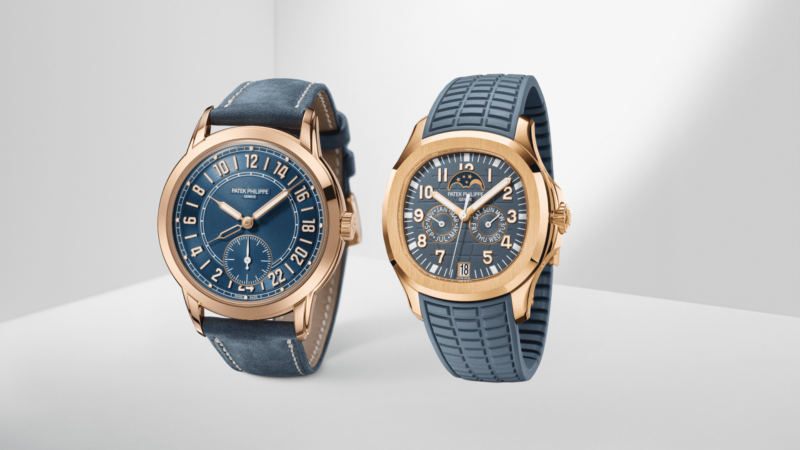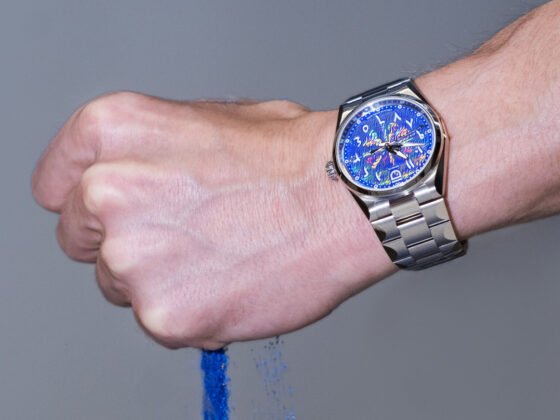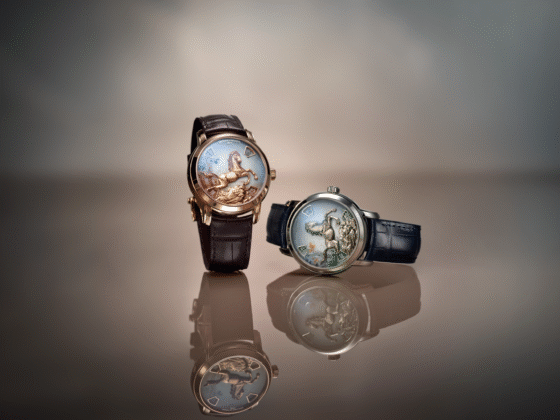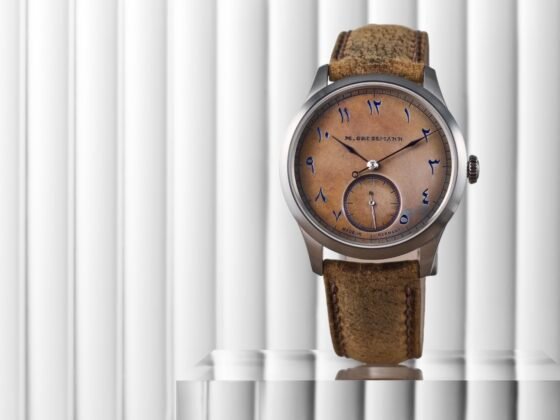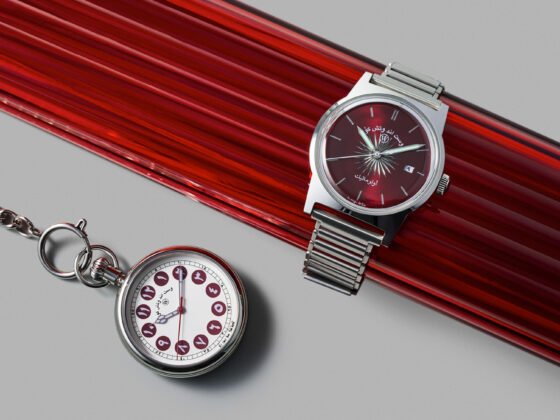Patek Philippe unveiled an impressive line-up of 17 new models at this year’s Watches & Wonders, which included five Grand Complications, four Complications, four Calatravas, one Gondolo, and three Aquanauts. Our focus here is on two of these models – the masculine Calatrava 24-Hour Display Travel Time and the feminine Aquanaut Luce Annual Calendar.
While both possess impressive complications in their own right, and share a common heritage, it is their complementary aesthetics featuring deep-blue hues and rose-gold that make them an exceptional his-and-her pair.
Calatrava 24-Hour Display Travel Time (Ref. 5224R-001), as the name suggests, is the latest addition to Patek’s expanding portfolio of travel watches and complications designed for everyday use. The new Calatrava model is equipped with a dual time zone function and a 24-hour display. Its new calibre 31-260 PS FUS 24H self-winding Aquanautmovement comes in an elegant rose-gold case with a navy-blue dial and strap.
Meanwhile, the Aquanaut Luce Annual Calendar (Ref. 5261R-001) is the first model in the Aquanaut collection to feature the patented Annual Calendar. This non-gemset Luce model comes with a matching dial and strap adorned in blue-grey, and like the Calatrava, is encased in exceptionally well-finished and elegant rose gold.

Patek’s exclusive Travel Time system displays a second time zone with two central hour hands, one of which can be adjusted backwards or forwards in one-hour steps. This complication is popular with clients thanks to its ease of operation and excellent legibility.
Patek has previously paired the Travel Time system to great effect with a variety of styles and dial designs, from the Grand Complication Alarm Travel Time model (5520P-001) to the ladies’ Aquanaut Luce Travel Time (5269/200R-001), among several others. The Travel Time complication is also found in two of the new Calatrava Pilot chronographs (5924G-001 and 5924G-010) unveiled at W&W23.
However, the new Calatrava Travel Time model debuts a new design to display the local and home time via two centre hands turning on a 24-hour circle. The manufacture has already used 24-hour displays in the past, notably on the Chronometro Gondolo watches produced in the early twentieth century. However, for the new Calatrava model, the designers have chosen to place noon at 12 o’clock, rather than at 6 o’clock, as in previous models, to improve legibility.

To power this watch, Patek’s engineers took the 31-260 ultra-thin self-winding base calibre and added a 24-hour mechanism and a Travel Time mechanism. This movement, launched in 2011 in the Annual Calendar Regulator (Ref. 5235) was entirely reworked in 2021 for the In-Line Perpetual Calendar (Ref. 5236P-001). It had an operating frequency of 4 Hz, a 20 per cent increase in barrel-spring torque, a mini-rotor in platinum to boos the winding power, and a reduction wheel that uncouples the self-winding mechanism.
In 2022, Patek Philippe reworked this movement again for the Annual Calendar Travel Time (Ref. 5326G-001) and developed several innovations, leading to eight patent applications. The latest iteration of this calibre – 31-260 PS FUS 24H – powering the new Calatrava Travel Time benefits from three of those patents.
Visible through a transparent sapphire-crystal back, the new self-winding calibre is compact enough to fit inside a 42 mm case with a height of 9.85?mm. The total height of the watch is 11.76 mm. To preserve its sleek lines, Patek also replaced the traditional correction pushers for local time on the left-hand flank of the case. It has a patented correction system, which is activated by pulling the crown out to the intermediate position.

The fully polished rose-gold case draws inspiration from the Calatrava Weekly Calendar (Ref. 5212A-001) launched in 2019, distinguished by its curved two-tier lugs. The navy-blue dial shines with its elegance and legibility. It is enhanced by a double railway-track scale for the hours and minutes. The 24-hour display – with its alternating Arabic numerals and hour markers, and its cabochon five-minute markers – comprises a total of 44 rose-gold appliques. All are polished together to obtain the same brilliance, and are applied individually by hand.
The Travel Time dual time zone is displayed by three syringe-shaped hands in rose gold. The local hour hand, the minute hand and the markers have a luminescent coating for a beautiful glow in the dark. Refined finishing touches create beautiful plays of light on the dial. A circular striated centre, a circular satin-finished hour circle and a snailed small-seconds counter with a rose-gilt outline all play their part in enhancing the watch’s appeal. A navy-blue calfskin strap – with a nubuck finish and contrasting cream stitching – echoes the colour of the dial. It is secured by a prong buckle in rose gold.
The Calatrava 24-Hour Display Travel Time’s companion from this year’s W&W debutants, the Aquanaut Luce Annual Calendar, features one of Patek’s patented mechanisms – a complete day/date/month calendar requiring only one manual correction per year, at the end of February.

Aquanaut Luce is a sub-collection within Aquanaut, launched in 2004, to appeal to the feminine casual-chic segment. It comprises a broad range of models, from stainless steel quartz models to Haute Joaillerie versions featuring the most sophisticated gem setting. Over the years, Patek Philippe has also endowed the Aquanaut Luce models with various complications, such as the Travel Time dual time zone or the self-winding chronograph. The new Aquanaut Luce Annual Calendar is the latest addition to this lineup.
Its 39.9 mm-diameter case houses the new self-winding 26-330 S QA LU calibre, with a central rotor in 21K gold and the additional Annual Calendar module with moon phases. A special feature of this watch is the inversion of the Annual Calendar module.
The calendar indications offer an unusual display compared to other Patek timepieces equipped with this complication. The date is displayed in an aperture at 6 o’clock, the moon phases in an aperture at 12 o’clock, and the day and month in subdials at 3 o’clock and 9 o’clock. The extremely precise moon phase indication deviates only one day in 122 years from the true lunar cycle.

The architecture of the movement is based on the calibre 26-330, introduced in the Calatrava Weekly Calendar (Ref. 5212A-001) – the same watch mentioned above as the inspiration for the new Calatrava 24-Hour Display Travel Time’s case design. The two timepieces, therefore, have a connection that goes beyond aesthetics.
The 26-330 calibre features several technical innovations. It has a patented anti-backlash wheel to prevent the seconds hand from vibrating. A patented clutch wheel improves the efficiency and longevity of the self-winding function. The presence of a “stop seconds” – which instantly stops the balance when the crown is pulled into the hand-setting position – allows adjustment to the nearest second. When the crown is pushed home, the mechanism gives a small impulse to the balance to set it in motion again.
On the aesthetic front, the timepiece’s rose gold case and bezel, with their rounded octagonal shape, are enhanced by the contrast between polished and satin finishes. The model’s casual-chic style is reinforced by the elegant blue-grey colour adorning the dial and strap. This refined hue has proven its appeal on the steel Aquanaut Luce 5067A-025, launched in 2018.

The dial, with the embossed Aquanaut pattern, features rose gold applied Arabic numerals and baton-style hands, all with white luminescent coating. The integrated composite strap with the Aquanaut pattern, echoing that of the dial, stands out for its comfort and high resistance to traction, wear, salt water and ultraviolet rays. It is fitted with a patented fold-over clasp.
Patek Philippe’s Calatrava 24-Hour Display Travel Time and Aquanaut Luce Annual Calendar, both debutants at this year’s W&W, both possess impressive complications, and both share lineage with the Calatrava Weekly Calendar of 2019. And, both are resplendent in their complementary combinations of deep-blue and rose-gold finishing, making them one of the standout his-and-her couplets of the season.

